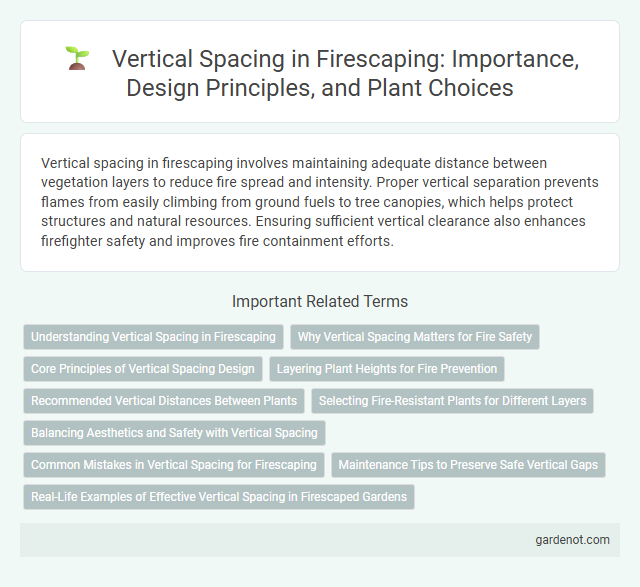Vertical spacing in firescaping involves maintaining adequate distance between vegetation layers to reduce fire spread and intensity. Proper vertical separation prevents flames from easily climbing from ground fuels to tree canopies, which helps protect structures and natural resources. Ensuring sufficient vertical clearance also enhances firefighter safety and improves fire containment efforts.
Understanding Vertical Spacing in Firescaping
Vertical spacing in firescaping refers to the strategic separation of vegetation layers, such as grasses, shrubs, and tree canopies, to prevent fire from climbing and intensifying. Maintaining a minimum vertical clearance of 3 to 6 feet between different plant layers reduces heat transfer and limits fire spread. Proper vertical spacing disrupts the fuel ladder effect, enhancing landscape fire resistance and protecting structures from wildfire damage.
Why Vertical Spacing Matters for Fire Safety
Vertical spacing plays a critical role in firescaping by preventing the rapid upward spread of flames between vegetation layers, reducing the risk of crown fires. Maintaining adequate vertical distance between ground fuels, shrubs, and tree canopies interrupts fire ladders and minimizes ember transfer. Effective vertical spacing enhances defensible space and protects structures from wildfire exposure.
Core Principles of Vertical Spacing Design
Vertical spacing in firescaping involves creating strategic distances between vegetation layers to prevent fire from easily climbing into tree canopies. Core principles include maintaining a minimum vertical separation of 3 to 6 feet between shrubs and lower tree branches, ensuring discontinuity in fuel ladders, and pruning lower branches to reduce fire spread potential. Proper vertical spacing reduces the risk of crown fires and enhances landscape defensibility around structures.
Layering Plant Heights for Fire Prevention
Layering plant heights creates vertical spacing that reduces fire spread by minimizing continuous fuel. Taller trees with well-pruned lower branches, combined with mid-height shrubs and low ground covers, break fire ladders and slow flame advancement. Strategic vertical plant arrangement enhances defensible space, improving overall fire prevention on the property.
Recommended Vertical Distances Between Plants
Recommended vertical distances between plants in firescaping vary based on species flammability and mature height, typically ranging from 18 to 36 inches to reduce fire spread. Maintaining appropriate vertical spacing creates fuel breaks that inhibit flame climbing and radiative heat transfer. Proper layering with non-flammable ground covers beneath taller shrubs further enhances fire resistance in landscaping.
Selecting Fire-Resistant Plants for Different Layers
Vertical spacing in firescaping is crucial for reducing wildfire risk by creating defensible space through layered vegetation management. Selecting fire-resistant plants for the ground cover, shrub, and tree layers ensures each tier has low flammability and retains moisture, effectively slowing fire spread. Incorporating species such as succulents, deciduous shrubs, and fire-resistant trees with non-resinous foliage enhances vertical separation and minimizes fuel continuity.
Balancing Aesthetics and Safety with Vertical Spacing
Vertical spacing in firescaping plays a crucial role in reducing fire hazards by creating defensible space between ground vegetation and tree canopies, thus preventing fire from rapidly climbing upwards. Properly balanced vertical spacing enhances safety without compromising the landscape's visual appeal by layering plants with varying heights and maintaining clear gaps. Implementing vertical breaks and pruning lower branches supports fire resistance while preserving the ecosystem's natural aesthetics.
Common Mistakes in Vertical Spacing for Firescaping
Common mistakes in vertical spacing for firescaping include placing combustible materials too close to overhanging tree branches or elevated deck structures, increasing fire hazards. Failing to maintain adequate vertical clearance of at least 10 feet between the ground and tree limbs creates opportunities for fire to climb and spread rapidly. Ignoring proper pruning practices that remove dead or low-hanging vegetation contributes significantly to vertical fuel continuity and fire intensity.
Maintenance Tips to Preserve Safe Vertical Gaps
Regularly trim vegetation and remove debris to maintain clear vertical spacing between plants and structures, reducing fire hazards. Inspect rooflines and overhangs quarterly to ensure no branches or flammable materials encroach on safe vertical gaps. Use fire-resistant materials and proper pruning techniques to preserve vertical clearance and enhance overall fire safety.
Real-Life Examples of Effective Vertical Spacing in Firescaped Gardens
Vertical spacing in firescaped gardens enhances fire resistance by strategically layering plants to reduce fuel continuity and improve airflow. For instance, the use of low-growing groundcovers beneath medium-height shrubs and taller fire-resistant trees, as seen in California's wildfire-prone landscapes, minimizes the risk of fire climbing vertically. Effective vertical spacing in Oregon's residential firescapes utilizes clear zones around structures, maintaining at least 12 feet of vertical separation between vegetation layers to disrupt fire pathways.
Vertical spacing Infographic

 gardenot.com
gardenot.com